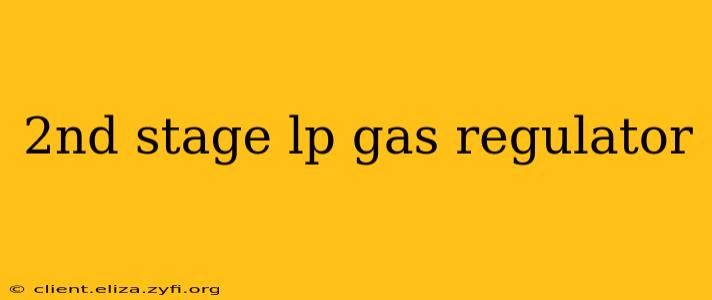LP gas, or liquefied petroleum gas, is a crucial fuel source for many homes and businesses. Its safe and efficient use relies heavily on the functionality of its regulators, particularly the second stage regulator. This component plays a vital role in controlling the gas flow from the tank to your appliances, ensuring a consistent and safe pressure. This guide will delve into the intricacies of the second stage LP gas regulator, addressing common questions and concerns.
What is a Second Stage LP Gas Regulator?
A second-stage LP gas regulator is the final component in the pressure reduction system. Unlike the first-stage regulator, which reduces the high pressure within the LP gas tank to a lower intermediate pressure, the second-stage regulator further reduces this pressure to a safe and usable level for your appliances, typically around 11 inches of water column (WC). This ensures the gas flows steadily and safely to your stove, furnace, or other gas-powered equipment without sudden pressure spikes. Think of it as the final gatekeeper before the gas reaches your home appliances.
How Does a Second Stage LP Gas Regulator Work?
The second-stage regulator employs a diaphragm and spring mechanism to precisely control gas flow. As gas flows into the regulator, the diaphragm is pushed upwards by the gas pressure. This movement compresses the spring, which in turn restricts the gas flow, maintaining a consistent output pressure. The spring's tension determines the set pressure, while the diaphragm ensures that pressure is consistently regulated regardless of fluctuations in the supply pressure from the first stage.
What are the Common Problems with Second Stage LP Gas Regulators?
Several issues can arise with second-stage regulators, leading to inefficient or unsafe operation. These include:
- Leaking: A leak can be detected by a hissing sound or the smell of gas. This is a serious safety hazard requiring immediate professional attention. Never attempt to repair a leaking regulator yourself.
- Low Gas Pressure: If your appliances are underperforming or not lighting properly, low gas pressure could be the culprit. This might indicate a faulty regulator or a clogged filter.
- Irregular Gas Flow: Erratic gas flow to your appliances usually suggests a problem with the regulator's diaphragm or spring mechanism.
How Often Should I Replace My Second Stage LP Gas Regulator?
While there's no hard and fast rule for replacement frequency, it's advisable to have your second-stage regulator inspected annually as part of a routine LP gas system check by a qualified technician. Regular inspections can identify potential issues before they escalate into safety hazards or equipment malfunctions. Consider replacing the regulator if it shows signs of damage, leaks, or inconsistent performance. The age of the regulator is also a factor; older regulators are more prone to failure.
What are the Signs I Need to Replace My Second Stage LP Gas Regulator?
Several signs point to the need for a new regulator:
- Visible Damage: Cracks, rust, or other physical damage compromise the regulator's integrity.
- Consistent Leaks: Even small leaks pose significant safety risks and necessitate immediate replacement.
- Inconsistent Gas Pressure: If appliances perform erratically, the regulator might not be maintaining consistent pressure.
- Older Regulator: Even without visible issues, older regulators should be considered for replacement as their components wear over time.
Can I Repair a Second Stage LP Gas Regulator Myself?
No. Repairing an LP gas regulator is extremely dangerous and should only be undertaken by trained and qualified professionals. Improper repairs can lead to gas leaks and explosions, posing serious risks to your safety and property. Always contact a certified LP gas technician for any regulator issues.
How Much Does a Second Stage LP Gas Regulator Cost?
The cost of a second-stage LP gas regulator varies depending on the make, model, and capacity. Prices range from relatively affordable to more expensive, high-capacity models. It’s best to contact your local LP gas supplier or hardware store for current pricing.
This comprehensive guide provides a thorough understanding of the second-stage LP gas regulator, its function, maintenance, and safety considerations. Remember, regular inspections and professional service are key to ensuring the safe and efficient operation of your LP gas system. Always prioritize safety and contact a qualified technician for any concerns or repairs.
